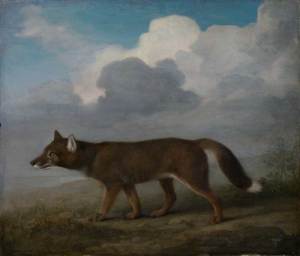There is a trend in museums to bring art and science together, to attempt to reconcile these often separate, sometimes antithetical, spheres of human knowledge. The latest example can be found in the newly refurbished rooms of the Queen’s House, Greenwich, where the art of Captain Cook’s voyages of discovery has been re-hung under the title ‘The Art and Science of Exploration’. Presenting the voyages as a grand Enlightenment enterprise of multi-disciplinary knowledge-gathering fits within the long-established hagiography of Cook, but does not tell the full story of the role art played in embedding these celebrated expeditions within the European imagination.
It is certainly true that the artists who sailed with Cook played a crucial role in documenting and disseminating knowledge about the lands, peoples and wildlife discovered during the voyages, and the exhibition expertly explains how this happened. But the relationship between art and science was not always as complementary, nor as high-minded, as the interpretation here would have us believe.

The Kongouro from New Holland (Kangaroo) (1772), George Stubbs. © National Maritime Museum, London
Take for example two new additions to the National Maritime Museum’s collection, on display for the first time since they were acquired in November 2013: George Stubbs’s The Kongouro from New Holland (‘Kangaroo’) and Portrait of a Large Dog (‘Dingo’). The two paintings are important additions to the museum’s meagre holdings of works related to Cook’s first voyage (1769–71). Kangaroo is particularly iconic, because it was the first depiction of this animal in Western Art, and it was through this image that the kangaroo came to symbolise Australia.

Portrait of a Large Dog (Dingo) (1772), George Stubbs © National Maritime Museum
But these paintings were not made in Australia, or even from live specimens. Stubbs, the leading animal painter of the day, was commissioned to paint them in London by Joseph Banks, the gentleman-naturalist who had accompanied Cook on the first expedition. In the case of Kangaroo, Stubbs based his painting on a skull and a stuffed or inflated pelt of the animal that Banks had brought back with him, but for Dingo the artist had little more than eye-witness accounts, which perhaps explains why his depiction looks like a strange cross between a fox and a badger.
Scientific accuracy was not the paramount concern (after all, there were very few in a position to dispute these descriptions). The commission was principally about creating images of the exotic that could be hung on the walls of the Royal Academy to satisfy the huge popular interest that the expedition attracted on Cook’s return. The art of the Cook voyages needs to be understood in these terms, as being as much about feeding (and controlling) the public’s appetite for the novel and the strange, as it was about observing and recording the new discoveries.

Poedua, the Daughter of Orio (c. 1784), John Webber © National Maritime Museum, London
John Webber’s Poedua, the Daughter of Orio may be the first portrait of a woman of the Pacific exhibited in Europe, but it was also a conscious contribution to the mythologising of the South Seas as an erotic paradise. The factual details of Webber’s depiction play second fiddle to the translation of Poedua into European conventions of feminine beauty, her transformation into a classical Venus, but with flowers in her hair and tattoos.
Throughout the exhibition we find other examples of artists deploying the models and devices of Western art in order to aestheticise their subjects, to make them more palatable for home audiences and to enhance the status of the images. This was not without its critics at the time, one writer complaining of those who ‘being intent on gaining the character of fine writers and elegant artists, have departed from the simplicity of Nature to give scope to the decorations of art’.

Tahiti Revisited (1776), William Hodges. © National Maritime Museum, London
To their credit, the curators have scrupulously identified which works were produced on the voyages, and which were created or re-worked in Britain, and have paid close attention to exhibition and reception histories. In the case of William Hodges, who is the best represented of all the artists in the exhibition, this allows some illuminating comparisons of his public works with the more experimental approaches he adopted in his on-the-spot studies made during the second voyage. And in a section examining the botanical drawings of Sydney Parkinson we can trace a sequential development from the initial sketches by Parkinson, through completed watercolours made by other artists, to the final copper plates and hand-coloured engravings made for publication, a process that reveals the progressive refinement and commoditisation of the image for public consumption.
The happy marriage of Art and Science provides a compelling theme with which to understand this important part of the National Maritime Museum’s collection. But there is a much bigger and more complex story that could be told here, about the role art played in shaping the public reception and appreciation of the Cook voyages in Britain, and more widely around the world.
‘The Art and Science of Exploration, 1768-80’ opened at the Queen’s House, part of the Royal Museums Greenwich, on 7 August.
In April 2015, George Stubbs’s The Kongouro from New Holland will start a 12 month tour to four museums: The Horniman Museum and Gardens, The Captain Cook Memorial Museum, Whitby, The Grant Museum of Zoology and the Hunterian Museum.
Related Articles
Art and science in conversation: why now? (Katy Barrett)
Unlimited access from just $16 every 3 months
Subscribe to get unlimited and exclusive access to the top art stories, interviews and exhibition reviews.














![Masterpiece [Re]discovery 2022. Photo: Ben Fisher Photography, courtesy of Masterpiece London](http://www.apollo-magazine.com/wp-content/uploads/2022/07/MPL2022_4263.jpg)
It’s time for the government of London to return to its rightful home